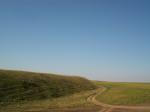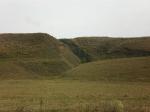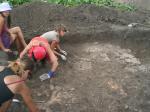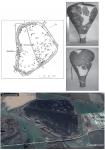Summary (English)
Two objects were explored during the season 2007.
First is ash hill 30 situated on the western periphery of the hillfort not far from the rampart. The explored area at the site measured 115m2. The southern part of ash hill 30 was covered with mixed soil that was dumped in the Early Modern period when the Cossacks used to mine saltpetre at the hillfort’s rampart. Thanks to that, numerous materials survived within the cultural layers below. Handmade pottery, mostly pots bowls and storage jars constituted the majority of the finds. Other tools of everyday life are knives, pins, arrowheads, etc. Besides that, more than two thousand animal bones were detected here. A big pit-house detected at the ancient buried surface was also explored here. It was a circle construction 5.25 m in diameter and 0.8 m deep. Two additional pits (cellars?) up to 0.8 m deep were placed at the NE and S corners of the basement. The dwelling was filled with ashy soil containing a lot of pottery shreds and Greek wares dated by the 6th c. BC.
Exploration at ash hill 13 were held since 2005. After the geophysics surveys, a trench measured 217 m2 was dug out at the S sector of the ash hill. Remnants of a dwelling and five non-simultaneous household pits were explored here. The dwelling measured 4.5 × 5.5 m. It was distinguished by two scattered Klazomenai amphorae dated by the early 6th c. BC that laid on the clay floor together with numerous fragments of storage jars. Also, a lot of the local wares fragments were detected within the mentioned objects. Besides that, a stone base of the altar with part of the clay floor was found near the dwelling. Similar religious structures were typical for the local farmsteads of the 6th c. BC.
- Shelekhan Oleksandr - Institute of Archaeology, National Academy of Sciences of Ukraine
Director
- Iryna Shramko - V.N. Karazin Kharkiv National University
- Stanislav Zadnikov - V.N. Karazin Kharkiv National University
Team
- Vladislav Bondarenko - V.N. Karazin Kharkiv National University, Museum of Archeology and Ethnography of Slobidska Ukraine
- Kseniia Bondar - Taras Shevchenko National University of Kyiv
Research Body
- ДП «Слобідська археологічна служба» ОАСУ Інституту археології НАН України / State enterprise «Slobidska archeological service» of the state enterprise «Protection of the archeological survey of Ukraine» of the Institute of Archeology of the National Academy of Sciences of Ukraine






![Download [PDF]](/excavation/skins/fasti/images/results/download_sml.png)


